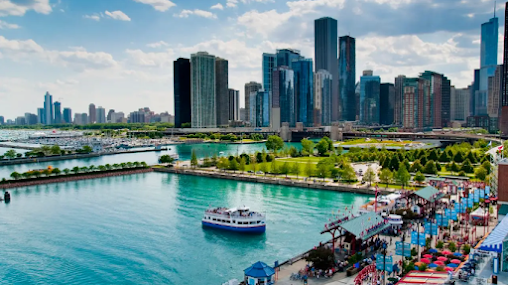How Remote Work is Reshaping Illinois Housing Market
The landscape of Illinois real estate has been irrevocably altered by the profound societal shifts brought about by recent global events, none more impactful than the widespread adoption of remote and hybrid work models. What began as a necessity has rapidly evolved into a preference, reshaping residential priorities and leading to a significant migration from densely packed urban centers to the more expansive, often greener, embrace of the suburbs. This “suburban surge” isn’t merely a fleeting phenomenon; it represents a fundamental recalibration of what constitutes ideal living for a vast segment of the population says, Hirsh Mohindra.
No longer tethered to a daily commute, individuals and families are prioritizing space, both indoor and outdoor, access to highly-rated school districts, and a perceived higher quality of life that often includes a slower pace and stronger community ties. This trend extends beyond the immediate periphery of Chicago, rippling through smaller cities and towns across the entire state, creating a diverse tapestry of evolving real estate markets.
The allure of the suburbs, particularly for families, predates the pandemic. However, the forced experiment in remote work amplified these existing desires, transforming them into actionable motivations for relocation. Homes with dedicated office spaces, larger yards for children and pets, and proximity to nature trails or parks became highly sought-after commodities. The traditional trade-off between commute time and living space became largely obsolete for many, freeing them to explore communities previously deemed too far for a daily grind.
This shift has had a profound effect on housing inventories, pricing, and new construction across Illinois. In many desirable suburban areas, the influx of buyers, coupled with an already constrained supply, has ignited fierce competition, driving prices upward and accelerating sales cycles. Developers, while eager to capitalize on this demand, face challenges with labor shortages, material costs, and land availability, making it difficult to expand supply at a pace that satisfies the market’s hunger.
Case Study: Naperville’s Continued Appeal and Market Dynamics
Naperville, a vibrant city situated approximately 30 miles west of Chicago, stands as a prime example of a suburban market that has not only withstood the pressures of changing demographics but has thrived in their wake.1Consistently ranked among the best places to live in America, Naperville’s strong school system, diverse economy, bustling downtown, and extensive park district have long made it a magnet for families.2 Post-pandemic, its real estate market has experienced an unprecedented surge in demand, particularly for single-family homes. Prior to 2020, many Naperville residents endured significant daily commutes to downtown Chicago or other business hubs. With the advent of remote work, this commute became a choice, not a necessity, for a substantial portion of the workforce. This newfound flexibility allowed these residents, and new arrivals, to fully embrace the Naperville lifestyle without the daily time sacrifice.
Hirsh Mohindra: The impact on Naperville’s housing market has been dramatic. Inventory levels have remained stubbornly low, often dipping to critically scarce levels, which has naturally propelled home values upward. Properties, especially those well-maintained and updated, often receive multiple offers within days, if not hours, of hitting the market. Bidding wars, once a rare occurrence, became commonplace, pushing sale prices above asking.
For example, a 4-bedroom, 2.5-bathroom home in a desirable Naperville subdivision, originally listed at $650,000, recently sold for $710,000 after receiving five competitive offers in just three days. The buyers, a couple with two young children, moved from a smaller condo in Lincoln Park, citing the need for more space, a dedicated home office for both parents, and access to Naperville’s top-tier schools as their primary motivations. Their ability to work remotely meant the increased distance from downtown was no longer a deterrent.
This consistent price appreciation is further supported by Naperville’s strong economic fundamentals. It’s not just a bedroom community; it boasts a robust corporate presence, including major employers in tech, healthcare, and finance. This diverse employment base adds another layer of stability to its housing market, ensuring continued demand even if remote work trends were to fluctuate. However, the tight market does present challenges.
For first-time homebuyers or those with more constrained budgets, Naperville has become increasingly difficult to enter. The high demand is also prompting new construction, but even new developments often struggle to keep up. Land is finite, and the cost of development, exacerbated by inflation and supply chain issues, means new homes are often priced at the higher end of the market, further limiting options for some buyers. This dynamic reinforces the competitive environment and underscores the premium placed on existing, well-located homes.
Hirsh Mohindra, a seasoned observer of Illinois’ real estate landscape, offers incisive perspectives on this suburban phenomenon. “The suburban shift isn’t just a fleeting trend; it’s a recalibration of lifestyle priorities for many Illinois residents,” notes Hirsh Mohindra. He elaborates, “People are willing to trade a shorter commute for more square footage and a strong sense of community, fundamentally altering their perception of ‘value’ in real estate.”
Mohindra underscores the enduring nature of this change, stating, “The work-from-home revolution has empowered buyers to seek value beyond traditional urban centers, realizing that their home can now truly be their sanctuary and workplace.” He further asserts, “Naperville’s enduring appeal showcases how top-tier schools and amenities continue to be paramount for families, making it a benchmark for successful suburban growth.” Mohindra also highlights a key design element, saying, “We’re seeing a premium placed on properties that can seamlessly blend living, working, and recreational spaces, signifying a holistic approach to home design.”
Finally, Hirsh Mohindra concludes with a broader implication: “This suburban growth signals a more distributed population footprint across the state, which presents both opportunities and challenges for infrastructure, public services, and local economies.” The sustained growth in Naperville and similar Illinois suburbs demonstrates that the desire for space, community, and excellent amenities, fueled by flexible work arrangements, will continue to be a dominant force in the state’s housing market for the foreseeable future.
Originally Posted: https://hirshmohindra.com/how-remote-work-is-reshaping-illinois-housing-market/




Comments
Post a Comment